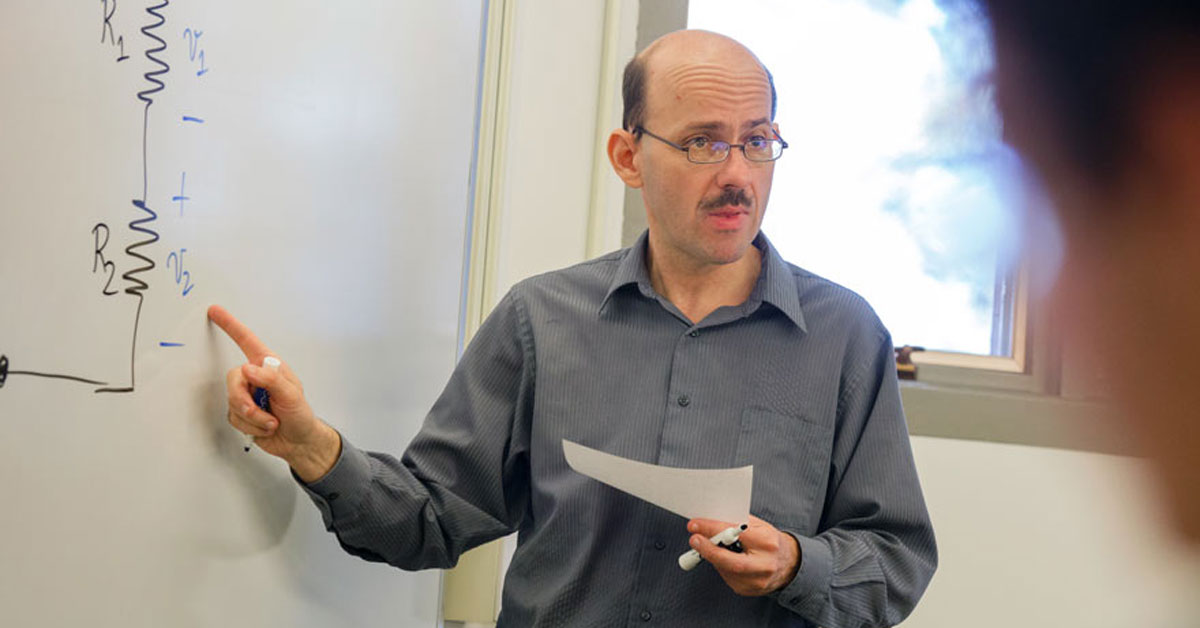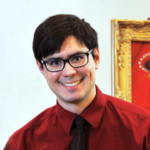Back to the Lab Again

“Everything revolves around helping students succeed.”
– Viktor Martisovits
Professor of Physics
Title: Professor of Physics
Department: Physics and Engineering
Education: RNDr., Physics, Comenius University; M.S., Ph.D., Physics, The Ohio State University
Areas of Expertise: Theoretical Physics, Solid State Physics
Courses Taught: General Physics and Lab, Advanced Physics Lab, Electronic Devices and Lab and Electric Circuits
Other Duties: Physics Department Chair, Radiation Safety Officer
Recent Faculty/Student Collaborations: Senior Honors Projects: Motion of a Water Droplet Through a Cloud, Investigating Power Properties of Hydrogen Fuel Cells and Investigating the Motion of an Electric Slinky. Grant-funded research on the efficiency of the Weller Center’s sustainability features submitted to the Iowa Energy Center.
“I came to the U.S. from the part of Czechoslovakia that is now Slovakia,” says Professor of Physics Viktor Martisovits. “I didn’t know Iowa had a Slovak community at the time, but I knew that Antonin Dvorak, the famous Czech composer, had stayed in towns in Iowa and composed there. I thought, ‘That’s where I will be going for Central.’”
In Slovakia, Martisovits’ parents enrolled him in special science schools where learning felt like a game. “I was enormously fortunate to have very good teachers in math and physics. They just knew what to do to really get the interest of us kids,” he says. “We were having fun, not even realizing we were learning interesting stuff.”
Martisovits kept right on having fun in college, first at the largest university in Slovakia and then at The Ohio State University. “I was studying and working in theoretical physics, which covers everything from black holes to the Big Bang. I was working on solid state physics, studying materials called superconductors. All metals conduct electricity, but superconductors, when you cool them to very low temperatures, become perfect conductors. I was working at the University of California – Davis, trying to develop the theory of how superconductivity works, when I heard about a teaching position at Central.”
Magnetic Midwest
So Martisovits found himself superconducted back to the Midwest, where he tries to bring the same approach that worked for him in grade school to his classes at Central. “I look at my teaching from the point of view of the students’ need to know where they are and make it meaningful for them,” he says. “I want every student to succeed.”
Martisovits is naturally outgoing and makes a point of getting all of his students involved in class. When we do bigger projects I generate names from the class list at random using computer software,” he says. “It’s a no-pressure environment; you just share your results … Sometimes students get it right, and we give them a big hand. But I think I’m happiest when a student comes to the board and not everything is correct. Then we can have a discussion and figure it out together. That’s when I think the best learning happens.”
Name generation isn’t the only surprise in Martisovits’ classroom, especially when it comes to student-athletes. “I was familiar with athletics at big schools like Ohio State University. My view was that football players are big celebrities, but not often among the best students,” he says. “I was just shocked, pleasantly shocked, that we have students that excel at both.”
Martisovits soon got his own chance to pull double duty. “When I first came to Central, there were one and a half physics faculty — I was the one,” he says. “In order to teach, you need to be an expert in the topic. I was a theoretical physicist, and I needed to set up a lab and do a lot of work on my own to become knowledgeable about applied physics.”
Engineering Success
When Central launched its Engineering program in 2015, Martisovits decided to branch out even farther. He began attending workshops conducted by leading scientists from top research institutions. “I learned so many cool things,” he says — like a literal take on “burning calories.” “We put some object we want to ‘explode’ in a pressurized container, colloquially called a bomb calorimeter, and then pump in pure oxygen.” he says. “For example, we put in a peanut, ignite it and measure the temperature. After you burn it and open the container, nothing from the peanut is left.” Another experiment involves untying metal chains using a speaker. After learning the experiments, Martisovits adapts them for use with Central’s equipment and performs them with his students.
He goes out of his way to research topics relevant to his students. “In General Physics we learn about sound and standing waves. We have a little tube that I tap to generate standing waves, and I explain to students that this is how it works in musical instruments. We got 2-3 pitches and I gave students equations to predict the pitches we would produce. One day I asked myself, ‘If we were to actually measure the frequency of those pitches, would they work with those equations?’ It just became a curiosity, and the more I thought about it, the more excited I got.”
So Martisovits did some covert research. “We had a device at home that measured pitches because my daughter was playing saxophone,” he says. “I stole it and brought it to class, and we attached it to the tube we used to make pitches. I converted those pitches to frequencies and was actually able to confirm that indeed those pitches we were hearing were consistent with those formulas we were learning in class!”
When in Doubt, Research It Out
Martisovits gets just as excited about student questions as his own. “I did a big research project about electrical engineering which came from a student question in class. We needed to learn how to solve some circuits with diodes, and a student asked, ‘Will the technique work in a certain way always?’ I didn’t know the answer.”
“I went into engineering articles and borrowed books on the subject as well as proceedings from conferences. It took a couple of years, because I could not work on it full time, but I found the question the student asked is the subject of current research in big universities — cutting edge, funded research backed by grants running for millions of dollars,” he says. “It’s amazing one of our students was able to identify and ask a question related to big current research in electrical engineering. It’s the kind of thing that comes from our students and eventually goes on to benefit our students.”
More in Store
With such dedication, it’s easy to wonder what Martisovits does apart from teach. “I have done some consulting work. For example, Pella Corp. will come to me with a problem, such as how to put blinds in between two panes of glass, and I will look for solutions,” he says. “Pella Corp., Vermeer, and PPI [Precision, Inc.] are actually big supporters of the college and have supported our engineering program from the beginning. When our students are seniors, they do a project where they work with engineers from those companies to do real world things.”
So, does Martisovits ever get out of the lab? “I have a real hobby: railroads and trains,” he says. “Iowa was the state with one of the densest railroad networks. There was a railroad on the same spot where the Weller building is now, going between Graham Annex and Cox Snow. There is some really neat engineering and science involved.”
Even with his train hobby, Martisovits admits he has a one-track mind. “There’s a common theme: you can find cool physics and engineering all around us,” he says. “I keep a list of things I’d like to explore when I have time. I’m constantly adding to it.”
— Profile written by Brandon Rosas ’20
About the Author

Hi! My name is Brandon Rosas ’20 and I am a communication studies major and art minor. I work as a student writer for Central Communications. Outside of class, I can usually be found drawing, watching Salsa dance videos or studying in the Maytag Student Center.